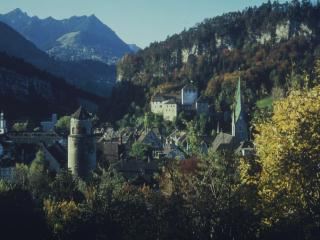
This mighty river flows full in the early summer, but meagerly in autumn from Ulm to Vienna. These variations in flow are a result of its many tributaries and the melting snows of late spring. The water is a milky white color during times of spate, and brown the rest of the year. It is navigable from the town of Passau southward, and a bustling river-trade characterizes the numerous towns and villages along the river's course. Numerous tolls are situated along the river, and commonly collected by the regent nobles.
A frontier town between Bavaria and Austria, this city sits at the junction of three rivers - the Inn, Danube, and the small river Ilz. Consequently, the town has grown into an important mercantile center. A bishopric, founded by St. Bonifce the Apostle of Germany, is seated here, and rivals that of Salzburg in its power and influence (currently the Babenberg family of Austria hold the Bishopric). Wooded rocks line the north bank of the Danube at the town, and where the rivers reach their confluence the Danube effectively doubles in size. Hence Passau marks the northernmost port along the mighty river (upstream in Germany the waters are not usually navigable). Imported cereals from Hungary, brought by trains of barges, are stored here and sold overland from markets held in the town.
Currently a castle, the Oberhaus, is being constructed on the north bank of the river on a rocky terrace. In 1220 the town will become a free city, and its bishop a Prince of the Empire. The next sizable port, Linz, lies 60 miles downriver, and beautiful Salzburg 88 miles to the south and east. Recently the town of Passau was witness to a miraculous event, the appearance of the archangel St. Michael (see the story summary St. Michael, the Avenging Angel), which lured folk from Rabenstein to hear the tale.
The castle of the Bishop of Passau, located about 8 miles south of the town on a hill overlooking the Inn river. The dense Sauwald lies north and east of the fortress.
Built in the early 13th Century with a triangular plan, this village lies almost exactly halfway from Paris to Vienna at the entrance to the Rhine Valley. The monestary of the Hospitallers of St. John of Jerusalem stands nearby, and the Shattenburg castle overlooks the town, with its mighty 12-foot thick walls. Zurich lies 80 miles away.

Feldkirch
An important trading stop and the crossroads for the Salt Trade which comes up from Hallstatt and the Traun river (in the vast Salt District) to reach Bohemia and Germany. Linz is the largest river town between Wien and Passau, and it lies 107 miles upriver from the former, straddling both sides of the Danube. This is a rapidly growing river-town, though its past dates back to Roman times. St. Martin's Church, built on Roman foundations of a Temple in the 8th Century, towers over the town. Called Lenetia by the Romans, the town is still dotted with temples to pagan gods, their architecture intact, but now converted to Christain faith.
The north bank is actually a suburb called Urfahr , while just south of town sits the Postlingberg hill, looming 1000 ft. above the town. To the southeast a valley expands along the Danube and the ground is naturally fertile, growing oats, cereals, sugarbeets, and fruit trees. Iron ore from the Erzberg and Ennstall valley is regularly shipped to Linz where it can be stored while it awaits transport to the rest of Europe.
North of town there arise steep rolling hills, called the Mohlviertel, and this denotes the border with Bohemia. Salzburg lies 79 miles to the southwest by road. Fransiscans will found a church here in the mid 13th Century (the Church of the Minorite Brothers).
Founded on the site of Florian's grave in the 11th Century by the Augustinians, this is an eminent cultural center. The Abbey's library features gold-encrusted walnut, and is quite extensive. It lies on a hill some 2 miles south of the Danube, though a road leads upriver to Linz.
St. Florian was converted to Christianity and martyred in 304 near the camp of Lauriacum, where he was thrown into the Enns river and drowned by fellow legionaires mocking his new faith. St. Florian, the patron saint of Austria, is constantly invoked against flooding or fires (often with the mischevous prayer, "good St. Florian, spare my house and rather burn my neighbor's"). Here a statue of him stands, depicted as a Roman legionaire holding an iron sprinkler.
This town lies 12 miles downriver from Linz at the confluence of the Danube and Enns rivers. See the Enns Valley notes for more.
The ruins of castle, destroyed in a petty conflict in 980, which overlook the Danube from above its north bank. The Abbey of Melk lies a scant 15 miles to the east.
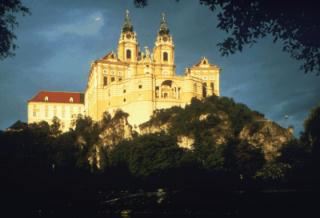 Built on a rocky bluff over 150 feet above the
south bank of the Danube, this mighty structure dominates the Danube for
miles, its great columns and windows an inspiration to many architects.
Leopold III gave the castle over to the Benedictines in 1089, who converted
it to this fortified Abbey. Its spiritual and intellectual prestige are
well-known throughout Austria and even Germany, and a village of the same
name, owned by the Abbot, lies along the banks of the Danube below.
Built on a rocky bluff over 150 feet above the
south bank of the Danube, this mighty structure dominates the Danube for
miles, its great columns and windows an inspiration to many architects.
Leopold III gave the castle over to the Benedictines in 1089, who converted
it to this fortified Abbey. Its spiritual and intellectual prestige are
well-known throughout Austria and even Germany, and a village of the same
name, owned by the Abbot, lies along the banks of the Danube below.
The high altar features two statues of St. Peter and Paul, to whom the church is consecrated, and 4 gilded wooden statues adorn the entry, each representing one of the 4 faculties. Paintings of the Baptism of Christ abound.
Lying 58 Miles from Linz, and 52 from Wien, the site was formerly theseat of the Babenbergs, and before that, originally a Roman stronghold. Melnik of Rabenstein once visited the Abbey, and due to his ties with the bishop of Seckau was able to view their expansive library.
A small castle built on a projected rock above the shore of the Danube, with pepper-pot towers and a bulbous, domed belfry. Fruit trees are tended around the castle. The peaks of the Otscher Massif rise behind this fort to the south, while the Waldviertel and Mohlviertel are visible across the river to the northeast and northwest respectively.
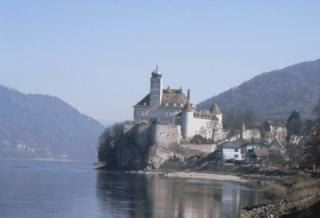
Schönbühel
A famous castle built in 1135 just 10 miles east of Melk. It is a large and highly coveted fortress, the mightiest along the entire Danube, situated on a rock over 1000 feet above the river. Currently the fortress is a stronghold of the Duke of Austria of the Babenberg family. A small, steep path leads down from the castle to the hamlet of Aggstein by the river.
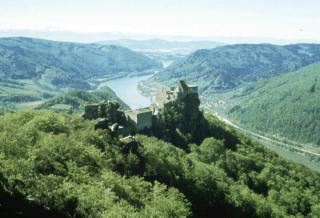
Aggstein
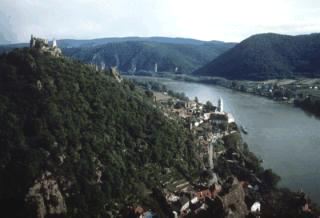 A fortified
village at the foot of a ridge in the rocky Wachau region of the Danube
river. It sits on the north shore of the Danube, at a bend in the river.
Terraced vineyards line a ridge above the town, and produce the fine Heuriger
wine for which the Wachau is famous. The town's main street, or "hauptstrasse,"
runs through the town end-to-end, bounded on the south by a fortified gate.
Inside, the Church of the Poor Clares tends to the villagers.
A fortified
village at the foot of a ridge in the rocky Wachau region of the Danube
river. It sits on the north shore of the Danube, at a bend in the river.
Terraced vineyards line a ridge above the town, and produce the fine Heuriger
wine for which the Wachau is famous. The town's main street, or "hauptstrasse,"
runs through the town end-to-end, bounded on the south by a fortified gate.
Inside, the Church of the Poor Clares tends to the villagers.
A castle of the same name lies about a 45-minute walk up a twisting path from the village below. Dilapidated Roman walls form the skeleton of the fortress, another stronghold of the Babenberg family.
When the Duke of Austria captured and imprisoned King Richard the Lionhearted of England during the Third Crusade, he imprisoned the monarch here at Dürnstein (during Richard's stay, until 1193, the king had an illustrious affair with the beautiful musician Blondel). Eventually Richard was transferred to the Imperial Castle of Trifels in Germany and ransomed back to England.
A monestary built along the Traisen river, a tributary of the Danube. It lies 11 miles south of Krems monestary. This Augustinian monastery was founded in the 12th Century by Bishop Ulrich of Passau and houses a growing collection of works of art and manuscripts. St. George and St. Stephen are the patrons and its library has several hundred illuminated manuscripts. Many wooden paintings adorn its interior.
This village along the banks of the Danube was once the site of the Roman camp of Comagena, and is today one of the seats of the Babenbergs. Its church is dedicated to St. Stephen, with a Romanesque doorway, framed with two towers with busts of the twelve apostles, and surrounded by the symbol of the Holy Roman Empire (a double-headed eagle).
In 1250 a vast funerary chapel will be built, called that of the three kings. Wine is grown in the surrounding hills.
This Benedictine Abbey stands just four miles north of Vienna on a hill known as the Kahlenberg heights overlooking the Danube. Just two miles further north lies the Kahlenberg, which itself stands 1000 ft. above the river below and offers a spectacular view of the surrounding area, including the mighty spire of the Cathedral of St. Stephen in nearby Vienna. The Chapter of Klosterneuberg has a magnificent alterpiece by Nicolas of Verdun, the master goldsmith, who finished it in 1151, and contains over 50 enameled subjects.
South of the Abbey towards Wien lie the vineyards of Grinzing, a small village famous for its succulent white wines.
A bluff, more of a hillock than a mountain, which marks the last foothill overlooking Vienna before the great plain of Hungary, standing above the Danube.
Originally a frontier fortress for the Romans, this river-town became the seat of the Babenberg family in 1155 when their ancestor Jasmirgott (Heinrich II) installed his Ducal court within the city at castle Am Hof. The town has had an illustrious past, as Emperor Marcus Aurelius was buried here in 180, and Attila and Kriemhild celebrated their wedding night here. During the 12th century it served as an important staging point for crusading knights, and due to its proximity to Bohemia and Hungary, it is one of the most important strategic points in all of the Holy Roman Empire. An important trading site, it contains an interesting albeit cosmopolitan mix of German, Magyar, Bohem, Slav, Italian, and Jew.
Vienna ('Wien' in German) expanded quickly after the Babenbergs made it their seat and today it is a thriving market town. It lies 126 miles northeast of Graz, 177 from Salzburg, 292 from Innsbruck, and by road, 821 miles to distant Paris.
The ruins of the old Roman fortress Vindobona stands near the center of town, its original walls still intact, though much of it now lies underground. Bognergasse, Goldscmiedgasse, and Kaufgergasse streets are the primary three streets, each lined with respected craftsmen. The Pfarr Church and the Church of St. Stephen, a cathedral under construction, are the center of divine influence. The center of the city is just outside the Cathedral, and is called the Stephensplatz. Just northeast of the square are the narrow streets of Schülerstrasse and Strobelgasse, which make up the business district (the Wollziele).
The Hofberg castle is a great walled palace and the seat of the Duke of Austria (currently under construction), a quadrilateral building with a round courtyard, which will eventually bristle with towers. It will house the treasury of the Duke, including a sizable collection of silver and gilt bowls and cups, precious jewelry, gems and religious relics (Vienna benefited greatly from the crusades). Muslim treasures and even Chinese porcelain manage to find their way here. The forterss harbors the Holy Lance which pierced Christ's side, a symbol of the Babenberg power, as well as a piece of the true cross. It will be completed about 1220.
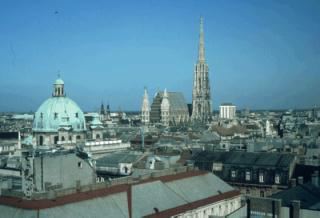 Built in the middle of the twelfth century,
with a belfry that rises like an arrow to an impressive height of 450 feet,
this Romanesque sanctuary dominates the landscape around the city. The high
alter has a piece representing the stoning of St. Stephen, as well as elaborate
wood paintings of the crowning of the virgin and child. Sculptures of the
life of the Virgin, Christ, and Christ in the Garden of Olives adorn the
south side. Catacombs below contain the organs of the Babenbergs in urns,
a secret tradition. In 1230, another basilica will begin construction (but
it will be severly damaged by the great fire of 1258 that sweeps the city).
In 1235, a Fransiscan church will be founded here.
Built in the middle of the twelfth century,
with a belfry that rises like an arrow to an impressive height of 450 feet,
this Romanesque sanctuary dominates the landscape around the city. The high
alter has a piece representing the stoning of St. Stephen, as well as elaborate
wood paintings of the crowning of the virgin and child. Sculptures of the
life of the Virgin, Christ, and Christ in the Garden of Olives adorn the
south side. Catacombs below contain the organs of the Babenbergs in urns,
a secret tradition. In 1230, another basilica will begin construction (but
it will be severly damaged by the great fire of 1258 that sweeps the city).
In 1235, a Fransiscan church will be founded here.
A 12th Century sanctuary on a terrace which overlooks the Danube. It boasts a 7-sided Gothic tower in the new style of France, which is capped by a pierced dome. Also, wood paintings of the Virgin adorn inside. Julian and Lassitor had cause to stay at this chapel to aid a member of the Esterhazy family in 1207 (see the story summary The Path of St. Michael), and are known to some of its tenants.
Established as a church and a sanctuary for the crusading order on their journeys to the Holy Land in 1156, this rich stucture has an alterpiece made of wood painted with scenes of the life of John the Baptist, the Crucifixion, and the Virgin and Child. Frederick Barbarosa paid tribute here on his last journey to the Holy Land (drowning en route).
This is the oldest church in the town, built on and incorporating one of the original Roman gates of Vindobona.
This page last modified on 2/9/08.
Comments to madirishman@mad-irishman.net
Return to the Rabenstein home page